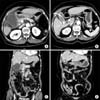Abstract
Backgrounds/Aims
In the treatment of complicated cholecystitis, laparoscopic cholecystectomy (LC) has limited efficacy due to its substantial post-operative complications. In addition, the clinical characteristics of complicated cholecystitis (CC) patients were suspected as advanced age with highly risky comorbidity. Percutaneous transhepatic gall bladder (PTGBD) drainage could be an alternative option for successful LC. Hence, this study evaluated the outcome of PTGBD for CC within and after 5 days.
Methods
The medical records of 109 consecutive CC patients who had undergone an LC between January 2007 and December 2011 were retrospectively reviewed and compared with the medical records of CC patients who had undergone an LC within 72 hours of (group I, n=63) or 5 days after PTGBD (group II, n=40). In addition, group I was divided into group Ia (n=46) and group Ib (n=17), according to the patients' development of open-conversion or post-operative complications. The clinical outcomes of the four groups were analyzed.
Results
There was a significantly higher reference to age, the ASA score grading, and predominant comorbidities in group II than in group I. The peri-operative results of group II showed lower blood loss and relatively shorter operating times than those of group I. In the cases of early LC within 72 hours (group Ia vs. group Ib), the difference was statistically insignificant.
Figures and Tables
 | Fig. 1Axial (A, B) and coronal (C, D) CT images of empyema of the gallbladder in an 82 year-old female patient. (A, C) Computed tomography scan shows a markedly dilated and gallbladder with ascites collection at perihepatic space. (B, D) Follow up CT image obtained 14 days after percutaneous transhepatic gallbladder drainage shows marked resolution of the abscess with drainage tube. |
Table 4
Comparison on development of perioperative difficulty or postoperative complication between early laparoscopic cholecystectomy of complicated cholecystitis

Surgery-related complications included bile leakage and subhepatic abscess formation. Cardiovascular complications included worsen existing disease, hypotension or arrhythmia. Respiratory complications included pneumonia and pulmonary embolism
Group Ia, no development of any complication with early laparoscopic cholecystectomy undergoing within 72 hours; Group Ib, development of some complications or open conversion with early laparoscopic cholecystectomy
References
1. Zucker KA, Flowers JL, Bailey RW, et al. Laparoscopic management of acute cholecystitis. Am J Surg. 1993. 165:508–514.
2. Knight JS, Mercer SJ, Somers SS, et al. Timing of urgent laparoscopic cholecystectomy does not influence conversion rate. Br J Surg. 2004. 91:601–604.
3. Habib FA, Kolachalam RB, Khilnani R, et al. Role of laparoscopic cholecystectomy in the management of gangrenous cholecystitis. Am J Surg. 2001. 181:71–75.
4. Kiviluoto T, Sirén J, Luukkonen P, et al. Randomised trial of laparoscopic versus open cholecystectomy for acute and gangrenous cholecystitis. Lancet. 1998. 351:321–325.
5. Radder RW. Ultrasonically guided percutaneous catheter drainage for gallbladder empyema. Diagn Imaging. 1980. 49:330–333.
6. Klimberg S, Hawkins I, Vogel SB. Percutaneous cholecystostomy for acute cholecystitis in high-risk patients. Am J Surg. 1987. 153:125–129.
7. Sugiyama M, Tokuhara M, Atomi Y. Is percutaneous cholecystostomy the optimal treatment for acute cholecystitis in the very elderly? World J Surg. 1998. 22:459–463.
8. Habib FA, Kolachalam RB, Khilnani R, et al. Role of laparoscopic cholecystectomy in the management of gangrenous cholecystitis. Am J Surg. 2001. 181:71–75.
9. Eldar S, Sabo E, Nash E, et al. Laparoscopic cholecystectomy for acute cholecystitis: prospective trial. World J Surg. 1997. 21:540–545.
10. Fletcher DR, Hobbs MS, Tan P, et al. Complications of cholecystectomy: risks of the laparoscopic approach and protective effects of operative cholangiography: a population-based study. Ann Surg. 1999. 229:449–457.
11. Bingener J, Richards ML, Schwesinger WH, et al. Laparoscopic cholecystectomy for elderly patients: gold standard for golden years? Arch Surg. 2003. 138:531–535.
12. Kanaan SA, Murayama KM, Merriam LT, et al. Risk factors for conversion of laparoscopic to open cholecystectomy. J Surg Res. 2002. 106:20–24.
13. Saxe A, Lawson J, Phillips E. Laparoscopic cholecystectomy in patients aged 65 or older. J Laparoendosc Surg. 1993. 3:215–219.
14. Chikamori F, Kuniyoshi N, Shibuya S, et al. Early scheduled laparoscopic cholecystectomy following percutaneous transhepatic gallbladder drainage for patients with acute cholecystitis. Surg Endosc. 2002. 16:1704–1707.
15. Kim IG, Jeon JY. Benefits of percutaneous transhepatic gallbladder drainage for laparoscopic cholecystectomy in patients with acute cholecystitis. Korean J Hepatobiliary Pancreat Surg. 2010. 14:46–52.
16. Farooq T, Buchanan G, Manda V, et al. Is early laparoscopic cholecystectomy safe after the "safe period"? J Laparoendosc Adv Surg Tech A. 2009. 19:471–474.
17. Daniak CN, Peretz D, Fine JM, et al. Factors associated with time to laparoscopic cholecystectomy for acute cholecystitis. World J Gastroenterol. 2008. 14:1084–1090.
18. Kim JM, Kim KS, Kim KH. Percutaneous gallbladder drainage and optimal timing for successful laparoscopic cholecystectomy in acute complicated cholecystitis. J Korean Surg Soc. 2007. 73:242–245.
19. Kim H, Kim HO, Shin JH. Comparison of early versus delayed laparoscopic cholecystectomy after percutaneous transhepatic gallbladder drainage (PTGBD) for patient with complicated acute cholecystitis. J Korean Surg Soc. 2007. 73:329–333.
20. Lee SM, Joe S, Lee MK, et al. Usefullness of preoperative percutaneous transhepatic GB drainage on laparoscopic cholecystectomy in patients with acute chlolecystitis. Korean J Hepatobiliary Pancreat Surg. 2002. 6:167–172.
21. Yun SS, Hwang DW, Kim SW, et al. Better treatment strategies for patients with acute cholecystitis and American Society of Anesthesiologists classification 3 or greater. Yonsei Med J. 2010. 51:540–545.
22. Lee AB, Lee HK, Min SK, et al. Clinical characteristics of complicated acute cholecystitis and its outcome of laparoscopic cholecystectomy. J Korean Surg Soc. 2006. 70:53–58.




 PDF
PDF ePub
ePub Citation
Citation Print
Print





 XML Download
XML Download